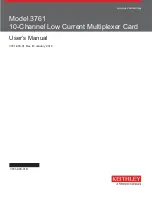
Using the RF Multiplexers 33
Chapter 3
Example: Tree Switching
Use tree switching to provide signal routing while maintaining characteristic
impedance. With tree switching, signal delay time is more than doubled
since the signal must pass through two or more channel banks plus extra
cabling. Keep cables as short as possible, especially between channel
banks, to minimize delay.
This example uses two RF Multiplexers in a tree configuration to connect
COM 10 of RF Multiplexer number 01 to channel 13 of RF Multiplexer 02.
The two RF Multiplexers form a multiple-multiplexer switchbox instrument.
In Figure 3-2,execute CLOS (@111,213) to connect COM 10 to channel 13.
Figure 3-2. Example: RF Multiplexer Tree Switching
Example: Matrix-Type
Switching
You can use matrix-type switching to provide connection of up to four
devices under test (DUT) to up to four test instruments. With this
configuration, only one channel in bank 0 (one “row”) can be connected to
one channel in bank 1 (one “column”) at a time.
This example uses one RF Multiplexer and one Expander in a matrix-type
configuration to connect channel 03 of the RF Multiplexer (module 00) to
channel 11 of the Expander (module 01). The RF Multiplexer and Expander
modules are defined as a single-multiplexer switchbox instrument. In Figure
3-3, execute CLOS (@10003,10111) to connect channel 03 to channel 11.
Figure 3-3. Example: Multiplexer/Expander Matrix Type Switching
Bank 1
RF Multiplexer 01
Com 10
Input/Output
Ch 10
Ch 11
Ch 12
Ch 13
Input/Output
RF Multiplexer 02
Com 10
Bank 1
Ch 13
Ch 11
Ch 12
Ch 10
Ch 03
Input/Output
RF Multiplexer 02
Bank 0
Ch 00
Ch 01
Ch 02
Com 00
(Module 00)
Ch 13
Input/Output
(Module 01)
Expander 01
Com 10
Bank 1
Ch 12
Ch 11
Ch 10
Artisan Technology Group - Quality Instrumentation ... Guaranteed | (888) 88-SOURCE | www.artisantg.com
















































